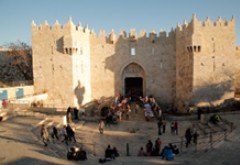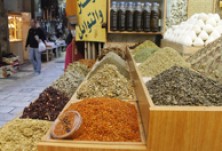To reach al-Marwani Mosque, the visitor must carefully walk down the steps of the Eastern Colonnade and move right (south) on the paved road that ends at the entrance of the northwest corner of al-Marwani Mosque. This entrance is one of three passageways that make up the closed triple gate, which is located in the southern part of the al-Aqsa Mosque’s wall, between the double gate and the single gate. That gate is the one used by visitors and worshipers at al-Marwani Mosque. The visit to al-Marwani Mosque by non-Muslims and non-locals requires prior coordination with the Islamic Awqaf (Religious Endowments) Department/Directorate of Archaeological Tourism.
What is al-Marwani Mosque?
Al-Marwani Mosque is a huge architectural structure. Its eastern and southern walls constitute the lower parts of the wall of al-Aqsa Mosque and the wall of the Old City of Jerusalem. It is, in fact, the boundary of al-Aqsa Mosque. The structure comprises porticoes that extend north to south. These include a set of semicircular archea , based on a large group of pillars constructed from huge stones. At the bottom of these pillars are hollow stone rings, which are said to have been used to tie up the horses used by the Franks when they resided in parts of al-Aqsa Mosque.
Original Purpose of the Mosque
In its current structure, al-Marwani Mosque is in reality a large, leveling area aimed at bridging the natural slope in the area of al-Aqsa Mosque. This was necessary in order to facilitate the construction of al-Jami’ al-Aqsa by ‘Abed al-Malik ibn IbnMarwan. The area of al-jami’ al-Aqsa , when it was established in 691 AD (72 H) was twice its current one, and it had 15 aisles instead of the present seven. Many of the stones that were available on site were re-used, particularly in the foundations and lower courses, while the upper courses, arches, and vaults were built with small stones. This concurs with the statements of the famous geographer, al-Muqaddisi, who said that the foundations of al-Jami’ al-Aqsa are old and that ‘Abed al-Malik built on it using smaller stones and created serrated outlooks, an architectural, decorative approach used for the tops of walls.
Origin and Meaning of the Name
Al-Marwani Mosque is a recent name given to the area that used to be called the Stable, or more specifically, Solomon’s Stables. Al-Marwani name refers to the Umayyad Caliph Marwan Ibnibn al-Hakam, the father of the caliphs ‘Abed al-Malik Ibnibn Marwan, Al-Walid, Suleiman and Hisham, who have all made noble contributions to the development of the area of al-Haram al-Sharif, architecturally and artistically. It was so named as a show of reverence to the father of those caliphs who contributed to the development of al-Aqsa Mosque. This name, which is historically evidenced, was launched in reaction to the wrongful name that had been prevalent, namely, the Stable or Solomon’s Stables. The name of al-Marwani Mosque became more widely accepted and familiar after the area was renovated by the Islamic Awqaf Department and al-Aqsa Mosque Restoration Committee, with the much appreciated support of many Arabs and Muslims who volunteered from all parts of Palestine, especially the town of Um al-Nour, in 1992 and later.
Reason for the Old Name
There is no accurate knowledge of the reason for giving the structure the name of Solomon’s Stables, which appeared in the footnotes of Islamic resources and references. This is particularly true since the architecture fabric of al-Marwani Mosque does not relate in any way to Prophet Solomon. The structure dates back to the Umayyad period, and more specifically to the ruling era of Caliph ‘Abed al-Malik Ibnibn Marwan. Calling al-Marwani Mosque by the name of Solomon’s Stables could be attributed to two reasons: the first stems from popular heritage and Islam, while the second could be related to the Franks.
As for the first, it is known that Prophet Solomon ibn Daoud has great stature and reverence in Islam and in the Holy Quran, which reflected on popular heritage and folklore. Prophet Solomon was mentioned 17 times in the Holy Quran, with significant content and stature. The Holy Quran says that Allah (God) Almighty gave Solomon wisdom, taught him the logic of the bird, and dedicated to him both man and demon . As such, it is very likely that when Muslim travelers and visitors saw important religious sites characterized by impressive architecture, large stones, huge lintels and massive pillars, they might have been so impressed and overstated their admiration by saying that such a site was not built by man, but by demon(jinn), and since the only person who has control over the jinn was Prophet Solomon, such sites were attributed to him. Indeed, it has become a familiar saying to refer to any structure that has large stones by saying that it is a Solomon construction. Since al-Marwani Mosque showed noteworthy architectural characteristics and large stones, it was attributed to Solomon without any historical or architectural verification, something that was not done in the Middle Ages. The traveler Nasir Khusrau, for example, said in his description of the old al-Aqsa: ‘In its construction, stones were used that no brain could comprehend how human beings could have moved or transported, and we were told that Suleiman ibn Daoud was the one who built it.’
What helped strengthen this name was what was circulated during theFranks occupation of the al-Aqsa Mosque. They had turned the middle and eastern parts of al-Jami’ al-Aqsa into a church and called it Temple Solomons. Moreover, a group of warrior Franks had taken up residence in the western part of al-Jami’ al-Aqsa , and they were known by the name of the Sovereign Military Order of Malta. Since these were warrior knights, they had to have their horses nearby and therefore used the area of al-Marwani Mosque as a place to keep the horses, particularly after they opened a doorway in the eastern part of the southern wall of al-Aqsa Mosque, known as the single gate to allow for the easy movement of horses. Additionally, this opinion was supported further by the presence of a large number of hollowed, carved rings in the stone pillars that carry the arches of al-Marwani Mosque. Consequently, the use of the area as stables determined its purpose, and since the Franks called the level above al-Marwani Mosque ‘Temple Solomons,’ it would be expected that the lower level would be called after Solomon, namely Solomon’s Stables. What may support this analysis is the fact that this name was not common until the Franks arrived in the area.
Position of Al-Marwani Mosque
Al-Marwani Mosque is an integral part of al-Aqsa Mosque. It is as holy as all the other parts and components of al-Aqsa Mosque. It was also an important element of the project of ‘Abed al-Malik Ibnibn Marwan to renovate and develop al-Aqsa Mosque. The area of al-Marwani Mosque received major attention during the Fatimid era. The renovation of al-Marwani Mosque was accompanied by a vicious campaign by a group of right-wing Israelis, who attacked the Islamic Awqaf and claimed that they were destroying artifacts pre-dating Islam, which has no foundation in any facts or archaeological findings.








